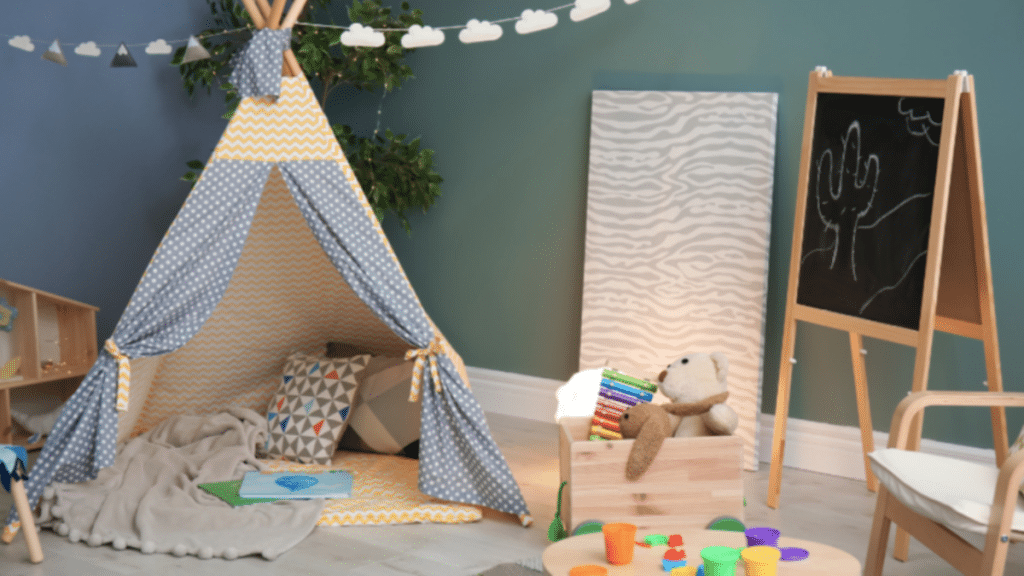Kids feel a lot of different emotions like excitement, frustration, sadness, and more.
Sometimes these feelings get too big, and that’s when having a calm-down corner at home can help. It might sound fancy, but it is really just a small, cozy spot in your house where kids or even grown-ups can take a break, breathe, and feel calm again.
You don’t need any fancy stuff or a big space. Just a simple, welcoming area that helps with calming down and handling feelings. Here is an easy guide to make one and ideas on what to put in it so it really works.
1. Pick the Right Spot
Start by choosing a quiet corner or small space that’s easy for your child to access but away from loud noises or distractions.
This could be a corner of their bedroom, a nook in the living room, or an unused part of the hallway. Really, any place works.
2. Make It Comfy and Inviting
Comfort helps kids relax, so add soft, inviting elements to make the space cozy.
Think cushions, pillows, or a bean bag chair, anything soft to sit or lean on. A small rug or blanket can add warmth and softness underfoot.
Use gentle lighting like a small lamp, nightlight, or fairy lights because harsh overhead lights can feel stressful.
For colors, choose calming tones such as pastels, light blues, greens, or neutrals to create a peaceful atmosphere. Keep it simple yet cozy because the goal is to make a spot your child genuinely wants to visit when emotions run high.
3. Add Simple Calming Tools
It’s helpful to provide a few simple, easy-to-use items that can help your child relax and focus their energy. However, too many options might feel overwhelming, so it’s best to stick with just a few favorites.
For example, coloring books and crayons or colored pencils are perfect because coloring calms the mind and lets kids express their creativity without any pressure. Along with that, fidget toys or stress balls can help release nervous energy and improve focus.
Sometimes children have trouble putting their feelings into words, so having emotion cards nearby lets them simply point to how they feel. Watching glitter slowly settle in a jar or sensory bottle is another soothing activity.
Adding a soft stuffed animal or a favorite pillow brings a sense of comfort and familiarity. To keep the calm-down corner feeling inviting and fresh, it’s a good idea to switch these items around every once in a while.
4. Set Clear, Positive Expectations
Explain to your child that the calm-down corner isn’t a place for punishment or time-outs. Instead, it’s a space they choose to visit when feelings get big and hard to handle.
Use encouraging language like: “If you ever feel upset, frustrated, or just need a quiet moment, you can go to your calm corner to feel better.”
Encourage them to use it anytime they want, and let them know it’s okay to take breaks when needed. This promotes emotional awareness and self-regulation.
5. Encourage Consistent Use and Model Calm Behavior
The calm-down corner works best when your child uses it regularly. You can gently remind them about the space during stressful moments and encourage them to take a break there when needed. It also helps if you practice calm-down strategies yourself and mention the corner as a useful tool.
When your child chooses to use the corner independently, be sure to praise and encourage them. Over time, this consistency helps build important habits of self-soothing and emotional control.
6. Understand the Mental Health Benefits
Having a special space dedicated to emotional regulation brings several benefits for kids.
It can reduce feelings of anxiety and frustration while improving their mood and ability to focus. It also helps children become more independent in managing their emotions and supports the development of emotional intelligence and resilience.
These skills are key to long-term mental wellness and preparing them to handle life’s ups and downs with confidence.
Final Words
Creating a calm-down corner at home is a simple and practical way to support your child’s emotional well-being. By providing a cozy space, a few calming tools, and positive guidance, kids can learn to take charge of their feelings and find peace when things get overwhelming.
This small investment of space and time can make a big difference in your child’s mental wellness and help them grow into emotionally balanced and resilient individuals.
